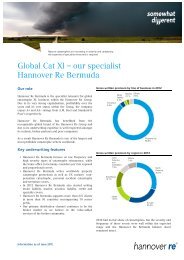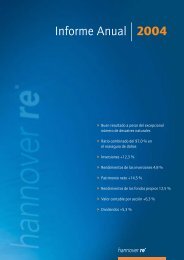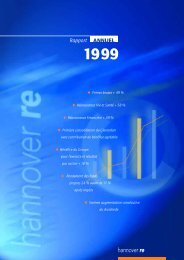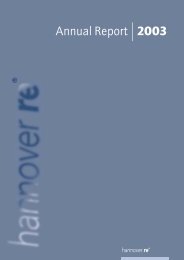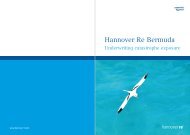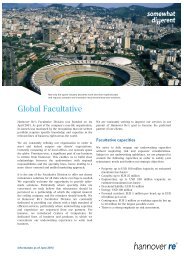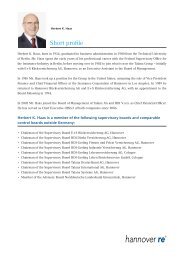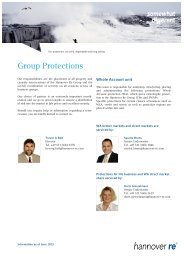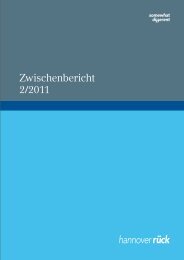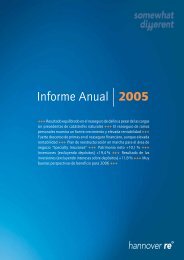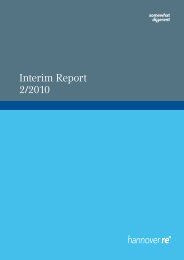Annual Report 2010 - Hannover Re
Annual Report 2010 - Hannover Re
Annual Report 2010 - Hannover Re
Create successful ePaper yourself
Turn your PDF publications into a flip-book with our unique Google optimized e-Paper software.
7. Other notes<br />
7.1 Derivative financial instruments<br />
Derivatives are financial instruments, the fair value of which<br />
is derived from an underlying instrument such as equities,<br />
bonds, indices or currencies. We use derivative financial instruments<br />
to a limited extent in order to hedge parts of our<br />
portfolio against interest rate and market price risks, optimise<br />
returns or realise intentions to buy/sell. In this context we take<br />
special care to limit the risks, select first-class counterparties<br />
and adhere strictly to the standards defined by investment<br />
guidelines.<br />
The fair values of the derivative financial instruments were<br />
determined on the basis of the market information available<br />
at the balance sheet date. Please see Section 3.2 “Summary<br />
of major accounting policies” with regard to the measurement<br />
models used. If the underlying transaction and the derivative<br />
are not carried as one unit, the derivative is recognised under<br />
other financial assets at fair value through profit or loss or<br />
under the other liabilities.<br />
<strong>Hannover</strong> <strong>Re</strong> holds derivative financial instruments to hedge<br />
interest rate risks from loans connected with the financing of<br />
real estate; these gave rise to recognition of other liabilities in<br />
an amount of EUR 2.3 million (previous year: none).<br />
<strong>Hannover</strong> <strong>Re</strong>’s portfolio contained derivative financial instruments<br />
as at the balance sheet date in the form of forward<br />
exchange transactions predominantly taken out to hedge cash<br />
flows from reinsurance contracts. These transactions gave rise<br />
to recognition of other liabilities in an amount of EUR 34.9<br />
million (other liabilities of EUR 17.8 million, other financial<br />
assets at fair value through profit or loss of EUR 0.2 million).<br />
In the year under review <strong>Hannover</strong> <strong>Re</strong> acquired derivative<br />
financial instruments to hedge inflation risks associated with<br />
the loss reserves in the technical account. These transactions<br />
resulted in the recognition of other liabilities amounting to<br />
EUR 31.4 million (previous year: none) and other financial<br />
assets at fair value through profit or loss in an amount of<br />
EUR 0.2 million (previous year: none).<br />
The fair values and notional values of the hedging instruments<br />
described above can be broken down as follows according to<br />
the maturities of the underlying forward transactions.<br />
Maturity structure of derivative financial instruments<br />
in EUR thousand<br />
Less than<br />
three months<br />
Three months<br />
to one year<br />
<strong>2010</strong><br />
One to five<br />
years<br />
Five to ten<br />
years<br />
Interest rate hedges<br />
Fair values – – (2,325) – (2,325)<br />
Notional values – – 61,011 – 61,011<br />
Currency hedges<br />
Fair values (1,349) (3,912) (18,129) (11,516) (34,906)<br />
Notional values 12,844 9,339 47,853 37,264 107,300<br />
Inflation hedges<br />
Fair values – – (31,227) – (31,227)<br />
Notional values – – 2,535,120 – 2,535,120<br />
Total hedging instruments<br />
Fair values (1,349) (3,912) (51,681) (11,516) (68,458)<br />
Notional values 12,844 9,339 2,643,984 37,264 2,703,431<br />
31.12.<br />
174 Notes 7.1 Derivative financial instruments<br />
<strong>Hannover</strong> <strong>Re</strong> Group annual report <strong>2010</strong>



